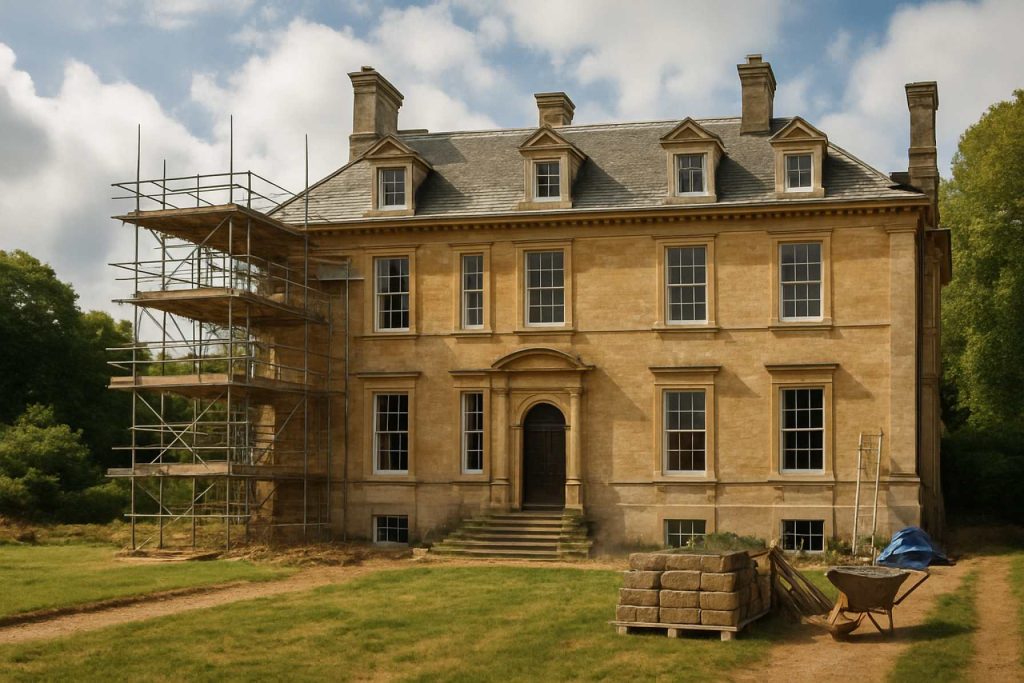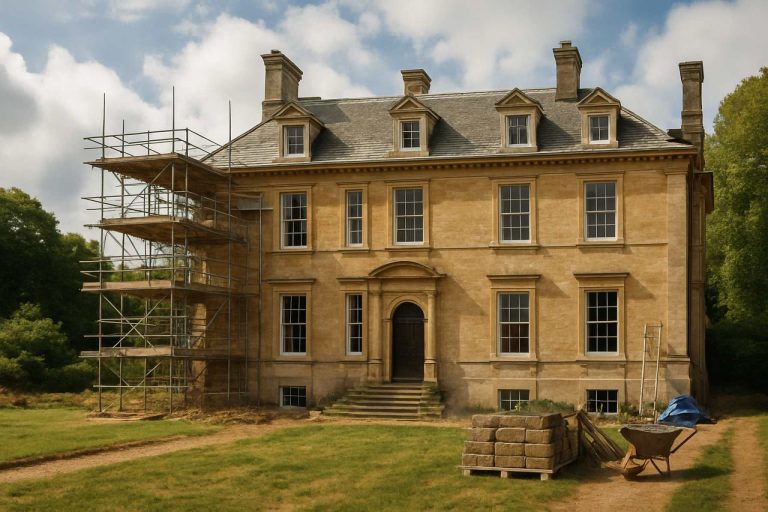
Inside the Renaissance: How Stately Home Restoration Trends Are Shaping the Future of Heritage Estates. Discover the Innovations, Challenges, and Surging Public Interest Transforming Historic Properties. (2025)
- Introduction: The Resurgence of Stately Home Restorations
- Market Growth & Public Interest: A 2024–2029 Outlook
- Sustainable Restoration: Eco-Friendly Materials and Methods
- Digital Technologies: 3D Scanning, BIM, and Virtual Tours
- Authenticity vs. Modernization: Balancing Heritage and Comfort
- Funding and Grants: Navigating Financial Support for Restorations
- Craftsmanship Revival: Skills, Training, and Artisan Shortages
- Case Studies: Award-Winning Restorations and Their Impact
- Regulatory Frameworks: Compliance, Conservation, and Planning
- Future Outlook: Predicting the Next Decade of Stately Home Restoration
- Sources & References
Introduction: The Resurgence of Stately Home Restorations
The restoration of stately homes—grand historic residences often set within extensive grounds—has experienced a marked resurgence in recent years, a trend that is expected to continue through 2025 and beyond. This renewed interest is driven by a combination of cultural, economic, and environmental factors. Across the United Kingdom and Europe, these properties are increasingly recognized not only as architectural treasures but also as vital components of national heritage and local economies.
Recent data from heritage organizations indicate a significant uptick in applications for restoration grants and planning permissions for listed buildings. For example, Historic England, the public body responsible for protecting England’s historic environment, has reported a steady increase in the number of stately home restoration projects supported through its Heritage at Risk program. Similarly, The National Trust, which manages hundreds of historic properties, has expanded its investment in both conservation and adaptive reuse initiatives, reflecting growing public and private sector commitment.
Several high-profile events have underscored this trend. The reopening of major estates following extensive restoration—such as the multi-year conservation of Wentworth Woodhouse and the ongoing revitalization of Castle Howard—has drawn significant public attention and visitor numbers. These projects often blend traditional craftsmanship with modern sustainability standards, aligning with broader environmental goals set by organizations like UNESCO World Heritage Centre, which advocates for the preservation of cultural heritage sites worldwide.
Looking ahead to 2025 and the following years, the outlook for stately home restoration remains robust. Policy frameworks in the UK and EU continue to prioritize heritage conservation, with increased funding streams and tax incentives for private owners and trusts. There is also a notable shift towards integrating green technologies—such as energy-efficient heating and renewable materials—into restoration plans, reflecting both regulatory requirements and evolving public expectations.
In summary, the resurgence of stately home restorations is characterized by heightened investment, innovative conservation practices, and a growing recognition of these properties’ value to society. As heritage bodies, private owners, and the public sector collaborate, the trend is set to shape the cultural landscape well into the next decade.
Market Growth & Public Interest: A 2024–2029 Outlook
The stately home restoration sector is experiencing a notable resurgence in market growth and public interest as of 2025, with projections indicating continued momentum through 2029. This trend is driven by a confluence of factors, including increased government and philanthropic funding, evolving heritage policies, and a growing appreciation for cultural tourism and sustainable reuse.
In the United Kingdom, which hosts a significant proportion of Europe’s stately homes, the Historic England organization has reported a marked uptick in grant applications and restoration projects since 2023. The Heritage Stimulus Fund, part of the government’s broader Culture Recovery Fund, has injected hundreds of millions of pounds into the sector, supporting both urgent repairs and long-term conservation. This funding has not only preserved historic fabric but also stimulated local economies and skilled employment.
Public engagement is also on the rise. According to data from the National Trust—the UK’s largest heritage conservation charity—visitor numbers to restored stately homes have rebounded to pre-pandemic levels, with some properties seeing record attendance in 2024 and early 2025. This surge is attributed to enhanced visitor experiences, such as immersive tours, digital interpretation, and expanded event programming, which have broadened the appeal of heritage sites to younger and more diverse audiences.
Sustainability is a defining trend shaping the outlook for stately home restoration. Organizations like Historic Environment Scotland are pioneering the integration of energy efficiency measures, renewable technologies, and climate resilience into restoration projects. These efforts align with national and international climate targets, positioning stately homes as exemplars of adaptive reuse and environmental stewardship.
Looking ahead to 2029, the sector is expected to benefit from continued investment, both public and private, as well as from policy initiatives that incentivize heritage-led regeneration. The European Union’s New European Bauhaus initiative, for example, is fostering cross-border collaboration and innovation in sustainable restoration practices. As a result, stately home restoration is poised to remain a vibrant and evolving field, balancing the imperatives of conservation, community engagement, and economic viability.
Sustainable Restoration: Eco-Friendly Materials and Methods
Sustainable restoration has become a defining trend in the stately home sector, with 2025 marking a significant shift toward eco-friendly materials and methods. Owners and custodians of historic estates are increasingly prioritizing environmental responsibility, driven by both regulatory pressures and a growing public expectation for heritage sites to lead by example in climate action.
A key development is the adoption of traditional materials sourced and processed with modern sustainability standards. Lime mortar, reclaimed timber, and natural stone are being favored over concrete and synthetic alternatives, as these materials not only preserve historical authenticity but also reduce embodied carbon. The Historic England organization, a statutory adviser on heritage conservation, has published updated guidance in 2024 encouraging the use of locally sourced, low-impact materials in restoration projects. This guidance is influencing grant criteria and planning permissions, making sustainable choices a practical necessity for many projects.
Energy efficiency retrofits are also gaining momentum. The integration of discreet insulation, secondary glazing, and renewable energy systems—such as ground-source heat pumps and solar slates designed to blend with historic roofs—has become more common. The National Trust, which manages hundreds of historic properties, has set ambitious targets to reduce its carbon footprint and is piloting innovative solutions like bio-based insulation and rainwater harvesting systems across several flagship estates. These initiatives are being closely monitored for their impact on both heritage value and environmental performance.
Data from the Historic Environment Scotland agency, which oversees conservation north of the border, shows a 30% increase in applications for eco-friendly restoration grants between 2022 and 2024. This surge is expected to continue as funding bodies increasingly tie financial support to demonstrable sustainability outcomes.
Looking ahead, the outlook for sustainable stately home restoration is robust. The sector is expected to see further innovation in bio-based materials, digital monitoring of building performance, and circular economy practices such as on-site material reuse. Collaboration between heritage organizations, academic researchers, and material manufacturers is likely to accelerate, with the aim of balancing conservation ethics with the urgent need for climate adaptation. As regulatory frameworks tighten and public awareness grows, eco-friendly restoration is set to become the norm rather than the exception in the preservation of the nation’s grandest homes.
Digital Technologies: 3D Scanning, BIM, and Virtual Tours
The integration of digital technologies such as 3D scanning, Building Information Modeling (BIM), and virtual tours is rapidly transforming stately home restoration in 2025 and is set to define best practices in the coming years. These tools are enabling more precise documentation, planning, and public engagement, addressing both conservation challenges and the need for sustainable management of heritage assets.
3D laser scanning has become a cornerstone in the initial assessment and ongoing monitoring of historic properties. By capturing millions of data points, these scans create highly accurate digital replicas of complex architectural features, which are invaluable for restoration planning and risk assessment. For example, organizations like Historic England have adopted 3D scanning to document vulnerable sites, allowing for detailed analysis without physical intervention. This technology also supports the creation of digital archives, ensuring that even if original features are lost, their details are preserved for future restoration.
Building Information Modeling (BIM) is increasingly being applied to heritage contexts, moving beyond its traditional use in new construction. BIM platforms allow multidisciplinary teams to collaborate on a single digital model, integrating historical data, structural analysis, and conservation requirements. This approach streamlines project management and helps anticipate potential conflicts between modern interventions and historic fabric. The National Trust, a major steward of stately homes in the UK, has piloted BIM in several restoration projects, reporting improved efficiency and better-informed decision-making.
Virtual tours, powered by high-resolution photography and 3D modeling, are now a standard feature for many stately homes. These tours serve dual purposes: they provide public access to sites during restoration or when physical visits are limited, and they act as educational tools to raise awareness about conservation efforts. The adoption of virtual experiences has accelerated since the COVID-19 pandemic and continues to expand, with institutions like English Heritage offering immersive online access to their properties.
Looking ahead, the convergence of these digital technologies is expected to deepen. Artificial intelligence and machine learning are being explored to automate damage detection and suggest restoration strategies based on digital models. As costs decrease and expertise grows, even smaller heritage organizations are likely to adopt these tools, democratizing access to advanced restoration methods. The trend points toward a future where digital documentation and engagement are integral to the stewardship of stately homes, ensuring their preservation for generations to come.
Authenticity vs. Modernization: Balancing Heritage and Comfort
The restoration of stately homes in 2025 is increasingly defined by the delicate balance between preserving historical authenticity and integrating modern comforts. Owners, conservation bodies, and architects are navigating a complex landscape shaped by evolving regulations, technological advancements, and shifting visitor expectations. This trend is particularly evident in the United Kingdom, where thousands of listed buildings are subject to strict heritage protections, but similar dynamics are seen across Europe and North America.
A key driver is the growing emphasis on sustainability and energy efficiency. The Historic England organization, which oversees the protection of England’s historic environment, has updated its guidance to encourage the sensitive incorporation of renewable energy systems, such as ground-source heat pumps and discreet solar panels, into heritage properties. These interventions are designed to reduce carbon footprints without compromising architectural integrity. In 2024, Historic England reported a 30% increase in applications for energy efficiency upgrades in listed homes compared to 2022, reflecting both regulatory incentives and owner demand.
At the same time, there is a renewed focus on using traditional materials and craftsmanship. Organizations like the National Trust, which manages over 500 historic properties in the UK, have launched apprenticeship programs to train artisans in heritage skills such as lime plastering, stone masonry, and timber framing. This ensures that restoration work remains faithful to original construction methods, a priority for both regulatory compliance and public trust.
However, modernization is not limited to sustainability. The integration of discreet modern amenities—such as underfloor heating, advanced security systems, and high-speed internet—has become standard in high-profile restorations. The English Heritage charity, responsible for the care of over 400 historic sites, has piloted projects where digital infrastructure is installed with minimal visual impact, using wireless technologies and concealed cabling.
Looking ahead, the outlook for stately home restoration is shaped by continued investment in research and technology. Digital modeling and non-invasive diagnostic tools are enabling more precise planning and less intrusive interventions. The sector is also responding to increased public engagement, with many organizations offering virtual tours and interactive exhibits to share restoration processes and decision-making with wider audiences.
In summary, the prevailing trend is a nuanced approach that honors the past while embracing the future. The challenge for 2025 and beyond will be to maintain this equilibrium, ensuring that stately homes remain both authentic cultural treasures and comfortable, sustainable spaces for generations to come.
Funding and Grants: Navigating Financial Support for Restorations
Securing adequate funding remains a central challenge for stately home restoration in 2025, but recent trends show a dynamic landscape of grants, public-private partnerships, and innovative financing models. In the United Kingdom, where many of Europe’s most iconic stately homes are located, the Historic England organization continues to play a pivotal role. Their Heritage at Risk Register and associated grant schemes have been instrumental in channeling millions of pounds annually into urgent repairs and conservation projects, with a particular focus on sustainability and climate resilience. In 2024–2025, Historic England increased its emphasis on energy efficiency retrofits, offering targeted funding for projects that integrate renewable energy or improve building insulation without compromising heritage value.
The National Trust, one of the largest conservation charities in the UK, has also expanded its grant-making and partnership activities. In 2025, the Trust is prioritizing stately homes that can demonstrate community engagement and educational outreach, reflecting a broader sector trend toward public benefit and accessibility. Their “Everyone Welcome” initiative, launched in 2023, continues to provide financial and technical support for projects that open up historic estates to wider audiences, with funding often tied to measurable social impact.
Across Europe, the European Union remains a significant source of restoration funding through programs such as Creative Europe and the European Regional Development Fund. These grants increasingly require cross-border collaboration and digital innovation, encouraging stately home owners to partner with cultural institutions and technology providers. The EU’s 2021–2027 budget cycle has earmarked substantial resources for heritage-led regeneration, with a focus on rural development and sustainable tourism.
Looking ahead, the outlook for stately home restoration funding is cautiously optimistic. While public funding remains competitive, there is a notable rise in philanthropic giving and corporate sponsorship, particularly for projects that align with environmental, social, and governance (ESG) goals. Digital fundraising platforms and crowdfunding campaigns are also gaining traction, enabling smaller estates to reach global audiences. However, experts caution that successful grant applications increasingly require robust business plans, clear community benefits, and demonstrable climate adaptation strategies.
- Historic England: Focus on sustainability and urgent repairs
- National Trust: Emphasis on accessibility and social impact
- European Union: Support for cross-border, innovative, and sustainable projects
- Emerging models: Philanthropy, ESG-aligned sponsorship, and digital fundraising
Craftsmanship Revival: Skills, Training, and Artisan Shortages
The restoration of stately homes in 2025 is increasingly defined by a renewed emphasis on traditional craftsmanship, yet this revival faces acute challenges due to skills shortages and the urgent need for specialized training. Across the United Kingdom and Europe, heritage organizations and property owners are reporting a critical lack of artisans skilled in stone masonry, timber framing, decorative plasterwork, and other heritage trades essential for authentic restoration. According to the Historic England, the sector is experiencing a “skills gap” as older craftspeople retire and fewer young people enter these professions, threatening the long-term sustainability of stately home conservation.
In response, leading heritage bodies are expanding training initiatives. The National Trust, which manages hundreds of historic properties, has increased its investment in apprenticeships and specialist training programs, aiming to double the number of heritage craft trainees by 2026. Similarly, the English Heritage Trust has launched new partnerships with technical colleges to deliver hands-on courses in lime plastering, leadwork, and conservation carpentry. These efforts are supported by government funding streams, such as the UK’s Heritage Crafts Fund, which prioritizes endangered skills and supports master-apprentice models.
Despite these initiatives, demand for skilled artisans continues to outstrip supply. The Heritage Crafts Association has placed several key restoration skills on its “Red List of Endangered Crafts,” highlighting the risk to stately home projects if recruitment and training do not accelerate. The situation is compounded by the complexity of restoration work, which often requires bespoke solutions and deep knowledge of historical techniques and materials. As a result, project timelines are lengthening and costs are rising, with some high-profile restorations delayed due to the unavailability of qualified craftspeople.
Looking ahead, the outlook for craftsmanship in stately home restoration is cautiously optimistic. The sector is witnessing a growing appreciation for the value of traditional skills, both for their cultural significance and their role in sustainable building practices. Digital tools and documentation are being used to supplement training, but the consensus among heritage organizations is that hands-on experience remains irreplaceable. The next few years will be critical: success will depend on sustained investment in training, greater collaboration between heritage bodies and educational institutions, and the ability to inspire a new generation to pursue careers in heritage crafts.
Case Studies: Award-Winning Restorations and Their Impact
In recent years, the restoration of stately homes has seen a surge in both ambition and recognition, with several high-profile projects earning prestigious awards and setting new benchmarks for the sector. These case studies not only highlight technical excellence but also demonstrate the broader cultural, economic, and environmental impacts of such undertakings.
One notable example is the restoration of Wentworth Woodhouse, a Grade I listed country house in South Yorkshire, which has become a flagship project for heritage-led regeneration. The National Trust and the Historic England have both played advisory roles, with the project receiving significant funding from the UK government’s Culture Recovery Fund. The restoration, which began in earnest in 2017 and continues through 2025, has been recognized for its innovative approach to structural stabilization and adaptive reuse, including the creation of new public spaces and event venues within the historic fabric. The project was awarded the 2024 Europa Nostra Award for Conservation, underscoring its exemplary standards and community engagement.
Another award-winning restoration is the transformation of Hillsborough Castle in Northern Ireland, managed by Historic Royal Palaces. The multi-phase project, completed in 2023, involved meticulous conservation of interiors and gardens, as well as the introduction of sustainable technologies to reduce the estate’s carbon footprint. The project received the Royal Institute of British Architects (RIBA) Conservation Award in 2024, highlighting the successful integration of heritage values with modern sustainability goals.
These restorations have had measurable impacts. According to Historic England, stately home restorations contribute significantly to local economies, supporting skilled jobs and boosting tourism. For example, Wentworth Woodhouse’s visitor numbers have increased by over 40% since the commencement of restoration works, and the site now hosts regular cultural events, further embedding it within the community.
Looking ahead, the outlook for stately home restoration remains positive. The UK government’s ongoing support for heritage projects, coupled with growing public interest in sustainable and adaptive reuse, suggests that award-winning restorations will continue to set trends. The sector is expected to prioritize energy efficiency, accessibility, and community engagement, ensuring that these historic estates remain relevant and resilient in the years to come.
Regulatory Frameworks: Compliance, Conservation, and Planning
The regulatory landscape for stately home restoration in 2025 is shaped by a complex interplay of heritage protection, planning policy, and evolving sustainability standards. In the United Kingdom, where many of Europe’s most iconic stately homes are located, the principal statutory framework remains the Planning (Listed Buildings and Conservation Areas) Act 1990, administered by Historic England. This body provides guidance, grants, and statutory advice for works affecting listed buildings and their settings. In 2025, Historic England continues to emphasize the importance of “conservation-led” approaches, requiring that any restoration or adaptation work preserves the special architectural and historic interest of these properties.
Recent years have seen a tightening of compliance requirements, particularly regarding energy efficiency and climate resilience. The UK government’s Department for Levelling Up, Housing and Communities has updated planning policy to encourage the sensitive integration of renewable energy systems, such as ground-source heat pumps and discreet solar installations, within historic estates. However, these interventions must be carefully balanced with conservation principles, often necessitating bespoke solutions and extensive consultation with local planning authorities and conservation officers.
Across Europe, the European Union continues to support heritage conservation through funding streams like the Creative Europe programme and the European Regional Development Fund, which prioritize projects that demonstrate both cultural value and sustainable adaptation. The Council of Europe’s Framework Convention on the Value of Cultural Heritage for Society (Faro Convention) also influences national policies, promoting public engagement and adaptive reuse as key strategies for the long-term viability of stately homes.
Data from Historic England and the National Trust—the UK’s largest heritage charity and custodian of hundreds of historic properties—indicate a steady increase in applications for restoration projects that incorporate both traditional craftsmanship and modern sustainability measures. The National Trust, in particular, has set ambitious targets for reducing the carbon footprint of its estate, driving innovation in materials and techniques while maintaining rigorous compliance with heritage standards.
Looking ahead, the regulatory outlook suggests further integration of environmental objectives into heritage policy, with digital planning tools and building information modeling (BIM) expected to streamline compliance and documentation. However, the core challenge remains: balancing the imperative to conserve historic character with the need to future-proof these irreplaceable assets for generations to come.
Future Outlook: Predicting the Next Decade of Stately Home Restoration
The future of stately home restoration is poised for significant transformation as we move through 2025 and into the next decade. Several converging trends are shaping the sector, driven by evolving conservation philosophies, technological advancements, and shifting societal expectations. These trends are being closely monitored and guided by leading heritage organizations, such as National Trust in the UK and English Heritage, both of which are responsible for the stewardship and restoration of hundreds of historic properties.
A key trend is the increasing integration of sustainability into restoration practices. The adoption of energy-efficient systems, use of traditional yet environmentally friendly materials, and the retrofitting of renewable energy solutions are becoming standard. For example, the National Trust has committed to achieving net zero carbon emissions by 2030, which directly influences restoration projects by prioritizing low-impact materials and technologies. This shift is expected to accelerate as regulatory frameworks tighten and public demand for sustainable heritage grows.
Digital technology is another major driver. The use of 3D scanning, Building Information Modelling (BIM), and virtual reality is revolutionizing how stately homes are surveyed, planned, and restored. These tools allow for precise documentation of historic fabric and enable more accurate, less invasive interventions. Organizations like Historic England are actively promoting digital skills and resources to support this transition, anticipating that digital-first approaches will become the norm by the end of the decade.
Community engagement and adaptive reuse are also gaining prominence. Restoration projects are increasingly designed to serve broader public purposes, such as education, cultural programming, and local economic development. This is reflected in the growing number of stately homes opening their doors for events, co-working spaces, and even affordable housing initiatives, as encouraged by English Heritage and similar bodies across Europe.
Looking ahead, the sector faces challenges, including funding constraints and the impacts of climate change, which threaten the physical integrity of many historic estates. However, the outlook remains optimistic. With continued investment from public and private sources, and the ongoing evolution of best practices, stately home restoration is expected to become more resilient, inclusive, and sustainable, ensuring these iconic properties remain relevant and accessible for future generations.
Sources & References
- Historic England
- The National Trust
- Historic Environment Scotland
- English Heritage
- Historic England
- National Trust
- European Union
- Heritage Crafts Association
- Department for Levelling Up, Housing and Communities
- European Union
- English Heritage



